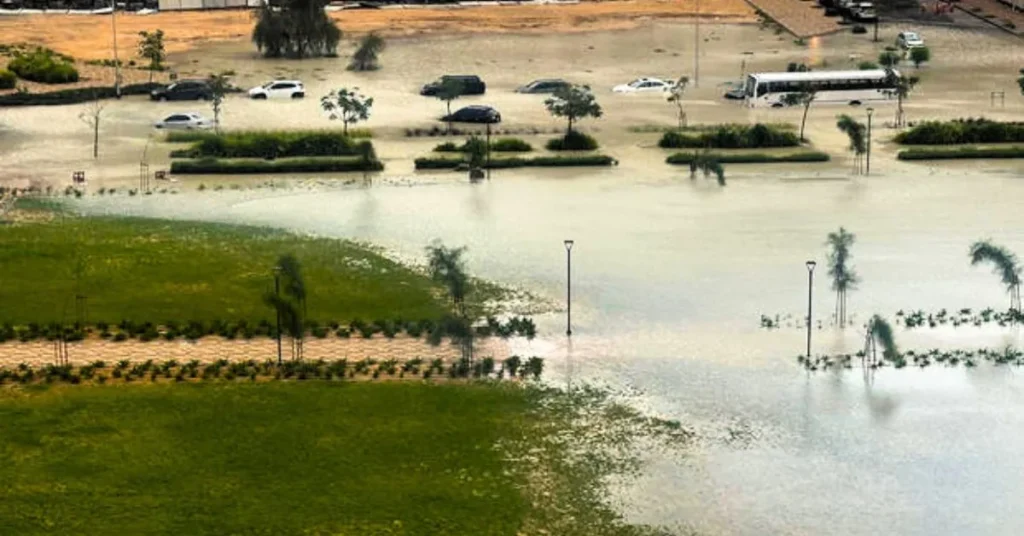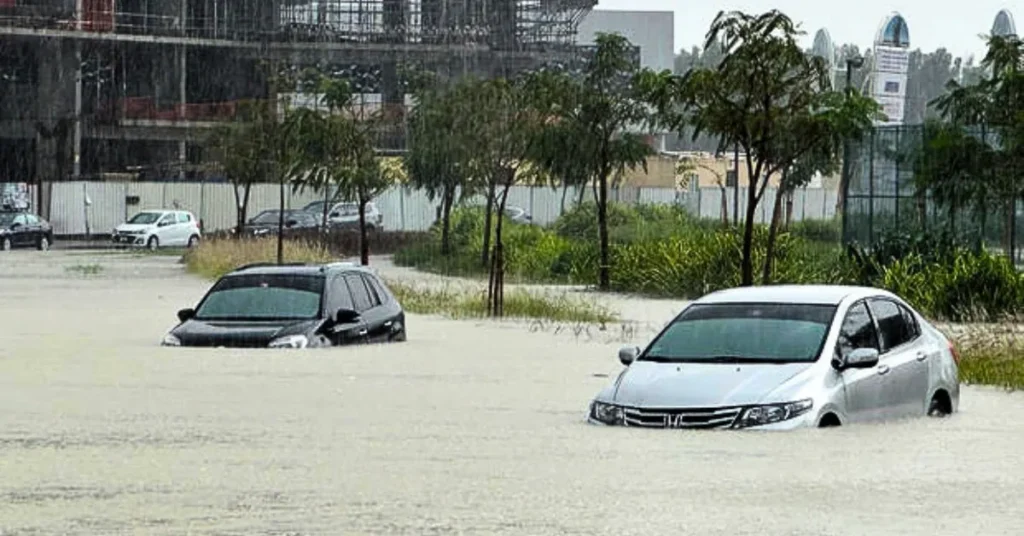
Dubai floods: The Arabian Peninsula experienced unprecedented rainfall and flooding, leading to the closure of schools and the grounding of flights on Wednesday. Parts of the United Arab Emirates, a desert nation, received 10 inches of rain within 24 hours.
In Oman, severe weather has resulted in the loss of at least 18 lives in recent days, according to the country’s National Committee for Emergency Management.
Table of Contents
The storms inundated roadways and created hazardous conditions across the region, which is typically arid and not accustomed to such intense rain and flash flooding.
Dubai’s airport urged passengers early Wednesday to avoid traveling to the airport unless necessary. Major airline Emirates announced the suspension of check-in services for all passengers in Dubai until midnight Wednesday (3 p.m. ET).
Read More: Diplomatic Tensions Between Israel and Iran Pose A Challenge For Biden
⚠️We advise you NOT to come to the airport, unless absolutely necessary.
— DXB (@DXB) April 17, 2024
Flights continue to be delayed and diverted. Please check your flight status directly with your airline.
We are working hard to recover operations as quickly as possible in very challenging conditions.
The National Center of Meteorology in Abu Dhabi stated that the rainfall in the UAE has exceeded anything recorded since data collection began in 1949 when the area was still under British protection and before the discovery of oil.
In the area of Khatm Al Shakla near Al Ain city, close to the Oman border, there was a recorded rainfall of 10 inches in less than 24 hours.
The meteorology center described it as “an unprecedented event in the UAE’s climate history since the commencement of climate data recording, and it is anticipated that larger amounts of rainfall will be recorded in the coming hours.”
Video obtained by Saudi Arabia’s state-owned news outlet Al Arabiya depicted the tarmac in Dubai submerged under floodwaters, with airplanes navigating through the inundation and support vehicles almost entirely submerged.

By midnight on Tuesday, Dubai had received 5.59 inches of rain within 24 hours. On average, only 3.73 inches of rainfall occur annually at Dubai Airport, which serves as a major travel hub in the Middle East and beyond.
The UAE’s National Emergency Crisis and Disaster Management Authority issued a warning, urging people to remain indoors. They advised parking vehicles in safe and elevated locations, away from flood-prone areas and places susceptible to water accumulation.
Private schools across the UAE preemptively closed ahead of the storm, and government employees were directed to work remotely.
The UAE, known for its dry climate, occasionally experiences precipitation during the winter months.
In neighboring Oman, recent storms and heavy rain led to the tragic loss of 10 schoolchildren and an adult driver whose vehicle was swept away by floodwaters, as reported by the AP.
Other parts of the Middle East, including Qatar and Saudi Arabia, also experienced unusually wet conditions this week.
While it’s too early to determine the role of global warming in these recent storms, studies have indicated that a warmer atmosphere resulting from climate change can hold more moisture. This increased moisture can contribute to more severe storms and intense rainfall events.
Flooding impacts Dubai International Airport
Dubai experienced an unusual deluge on Tuesday, with more than 5.59 inches of rain falling within 24 hours. This amount far exceeds the average annual rainfall of 3.73 inches at Dubai International Airport, which serves as a major hub for the airline Emirates.

At the airport, standing water accumulated on taxiways, creating challenges for landing aircraft. Arrivals were halted on Tuesday night, and passengers encountered difficulties reaching terminals due to flooded roads.
In response to the adverse conditions, the airport announced via social media that all operations were suspended for approximately 25 minutes on Tuesday afternoon. Subsequently, all incoming flights were diverted until weather conditions improved. As of late Wednesday morning, both the airport and Emirates were still advising travelers to avoid unnecessary visits to the airport, as flight check-in remained suspended.
The situation underscores the severity of the weather event and its impact on air travel in the region.
“Flights are still experiencing delays and diversions. Please check your flight status directly with your airline,” the airport tweeted. “We’re putting in every effort to restore operations as swiftly as possible despite the challenging conditions.”
Speaking anonymously to The Associated Press due to strict laws against criticism in their country, one couple described the scene at the airport as “chaos.”
“It’s impossible to find a taxi. People are sleeping in the Metro station. People are sleeping in the airport,” the man remarked on Wednesday.
Attempting to reach their home about 18 miles away, the couple encountered flooded roads that halted their taxi. Thankfully, a passerby assisted them over a highway barrier with their carry-on luggage, including bottles of gin they had purchased from a duty-free store.
Paul Griffiths, the CEO of the airport, talked about the ongoing flooding issues on Wednesday morning, mentioning that every available parking spot for aircraft was occupied. Some planes had to be redirected to Al Maktoum International Airport at Dubai World Central, the city’s second airport.
“It’s been tough. I don’t think anyone can remember ever facing conditions like these,” Griffiths shared on Dubai Eye, a radio station owned by the state. “We’re navigating uncharted waters, but rest assured, we’re giving it our all to ensure our passengers and staff are taken care of.”
Is “cloud-seeding” a contributing factor to Dubai flooding?
Rain also fell in Bahrain, Oman, Qatar, and Saudi Arabia, but the UAE experienced particularly heavy rainfall. One possible explanation could be the practice of “cloud seeding,” where government-operated aircraft release special salt flares into clouds to stimulate precipitation.

According to several reports, meteorologists at the National Center for Meteorology conducted six or seven cloud-seeding flights before the rains. Although the center didn’t immediately respond to inquiries on Wednesday, flight-tracking data analyzed by the AP indicated that one aircraft associated with the UAE’s cloud-seeding efforts flew across the country on Sunday.
The UAE, heavily reliant on energy-intensive desalination plants for water, employs cloud seeding as a means to supplement its limited groundwater resources.
Dubai Flooding: Closes Schools and offices across the Country
Schools across the UAE, which consists of seven sheikhdoms, mostly closed in anticipation of the storm, and government employees were encouraged to work remotely whenever possible. Many workers opted to stay home, although some braved the conditions, only to find themselves stranded as their vehicles became stuck in unexpectedly deep water on certain roads.
Authorities dispatched tanker trucks to pump water off the streets and highways, while some homes experienced flooding, forcing residents to bail out water.
The country’s leaders did not provide comprehensive information on the extent of damage or injuries nationwide. Some individuals spent Tuesday night in their flooded vehicles. In Ras al-Khaimah, the northernmost emirate, police reported the tragic death of a 70-year-old man whose vehicle was swept away by floodwater.
Fujairah, an emirate located on the UAE’s eastern coast, recorded the highest rainfall on Tuesday, with 5.7 inches falling in the area.
As a precautionary measure, authorities canceled school and mandated remote work for government employees again on Wednesday.

Rain is unusual in the UAE, an arid nation located on the Arabian Peninsula, but it does occur periodically during the cooler winter months. Due to the infrequency of rainfall, many roads and areas lack proper drainage, leading to flooding during heavy downpours.
In neighboring Oman, situated on the eastern edge of the Arabian Peninsula, heavy rains in recent days have resulted in the tragic loss of at least 19 lives, as reported by the country’s National Committee for Emergency Management on Wednesday. Among the casualties were 10 schoolchildren who were swept away in a vehicle along with an adult, prompting condolences from leaders across the region.
Climatologists have long warned about the impacts of human-driven climate change, which are contributing to more extreme and less predictable weather events worldwide.
Meanwhile, parts of southern Russia and Central Asia have also been grappling with unusually severe rainfall and snowmelt for days. This has forced tens of thousands of people to evacuate to higher ground and has tragically claimed the lives of more than 60 individuals in Pakistan and Afghanistan.

